Discover 35 hidden attractions, cool sights, and unusual things to do in Evanston (United States). Don't miss out on these must-see attractions: Grosse Point Light, Charles Gates Dawes House, and Ryan Field Stadium. Also, be sure to include Mary and Leigh Block Museum of Art in your itinerary.
Below, you can find the list of the most amazing places you should visit in Evanston (Illinois).
Table of Contents
Grosse Point Light
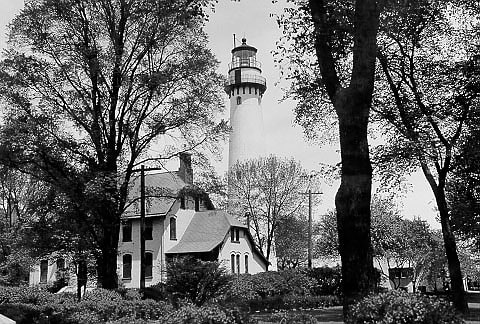
Lighthouse in Evanston, Illinois. The historic Grosse Point Light is located in Evanston, Illinois. Following several shipping disasters near Evanston, residents successfully lobbied the federal government for a lighthouse. Construction was completed in 1873. The lighthouse was added to the National Register of Historic Places on September 8, 1976. On 20 January 1999, the lighthouse was designated a National Historic Landmark. It is maintained under the jurisdiction of the Evanston Lighthouse Park District, an independent taxing authority.[1]
Address: 2601 Sheridan Rd, 60201-1752 Evanston (North Shore)
Charles Gates Dawes House
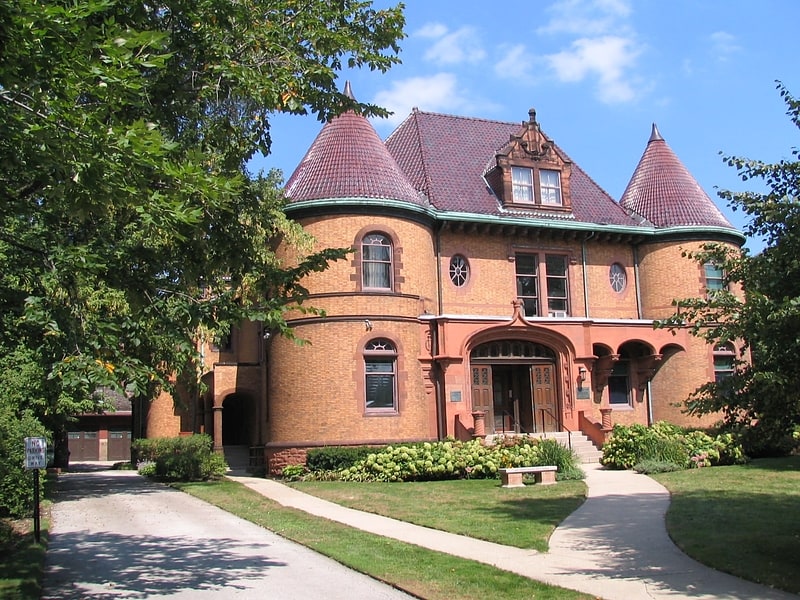
Museum in Evanston, Illinois. The Charles Gates Dawes House is a historic house museum at 225 Greenwood Street in Evanston, Illinois. Built in 1894, this Chateauesque lakefront mansion was from 1909 until his death the home of Charles Gates Dawes and his family. Dawes earned the 1925 Nobel Peace Prize for his plan to alleviate the crushing burden of war reparations Germany was required to pay after World War I. Dawes served as U.S. Vice President under Calvin Coolidge, a general during World War I, and as United States Ambassador to Great Britain. Dawes was a descendant of William Dawes, who along with Paul Revere, rode to alarm the colonists that the British regulars were coming on the night before the Revolutionary War began. The house, a National Historic Landmark, is now owned by the Evanston History Center, which offers tours.[2]
Address: 225 Greenwood St, 60201 Evanston (North Shore)
Ryan Field Stadium
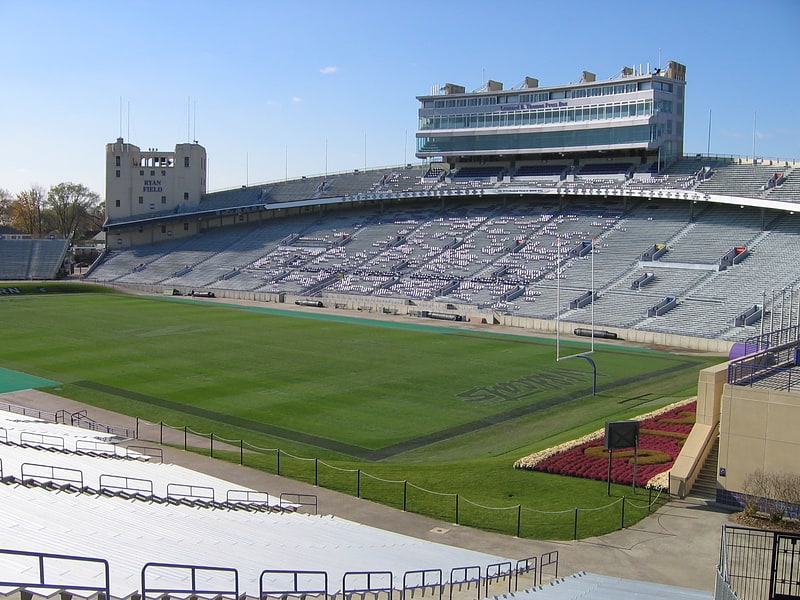
Stadium in Evanston, Illinois. Ryan Field is a stadium in Evanston, Illinois, a suburb north of Chicago. Near the campus of Northwestern University, it is primarily used for American football, and is the home field of the Northwestern Wildcats of the Big Ten Conference. It is the only FBS stadium without permanent lighting. Its current seating capacity is 47,130.
Opened 96 years ago in 1926, it was named Dyche Stadium for William Dyche, class of 1882, Evanston mayor from 1895 to 1899 and overseer of the building project. The stadium was renamed Ryan Field in 1997 in honor of the family of Aon Corporation founder Patrick G. Ryan, who was then the chairman of Northwestern's board of trustees. The renaming was made by the other members of the board in recognition of the Ryan family's leadership and numerous contributions to Northwestern, including the lead gift to the Campaign for Athletic Excellence, Northwestern's fundraising drive for athletic facilities.[3]
Address: 1501 Central St, 60208-3630 Evanston (North Shore)
Mary and Leigh Block Museum of Art
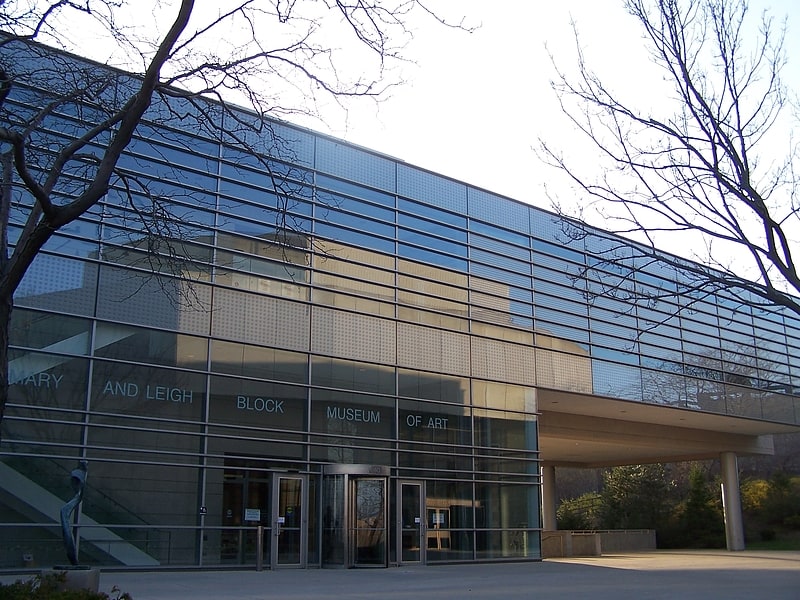
Art museum in Evanston, Illinois. The Block Museum of Art is a free public art museum located on the campus of Northwestern University in Evanston, Illinois. The Block Museum was established in 1980 when Chicago art collectors Mary and Leigh B. Block, donated funds to Northwestern University for the construction of an art exhibition venue. In recognition of their gift, the University named the changing exhibition space the Mary and Leigh Block Gallery. The original conception of the museum was modeled on the German kunsthalle tradition, with no permanent collection, and a series of changing temporary exhibits. However, the Block Museum soon began to acquire a permanent collection as the University transferred many of its art pieces to the museum. In recognition of its growing collection and its expanding programming, the Gallery became the American Alliance of Museums accredited Mary and Leigh Block Museum of Art in 1998. The Block embarked on a major reconstruction project in 1999 and reopened in a new facility in September 2000.
The Block Museum is dedicated to presenting programs and exhibitions that resonate with the curriculum, research and teaching areas of Northwestern University and are relevant to student, local and regional audiences. The Block Museum of Art enriches teaching and learning on the campuses of Northwestern University and in the communities of their surrounding regions by presenting art across time, cultures, and media; convening interdisciplinary discussions in which art is a springboard for exploring issues and ideas and collecting art that supports the Northwestern University curriculum. The museum also commissions new work by artists to foster connections between artists and the public through the creative process. Each year, the Block mounts exhibitions; organizes and hosts lectures, symposia, and workshops involving artists, scholars, curators, and critics; and screens classic and contemporary films at its in-house cinema.
The Block Museum has strong partnerships with museums worldwide including with the Yale University Art Gallery, Princeton University Press, The Nasher Art Museum at Duke University, the Grey Art Gallery at NYU, and the Museum der Moderne Salzburg. The Block often collaborates with these museums on exhibitions that travel across the country and the world.[4]
Address: 40 Arts Circle Dr, 60208-0883 Evanston (North Shore)
Welsh-Ryan Arena
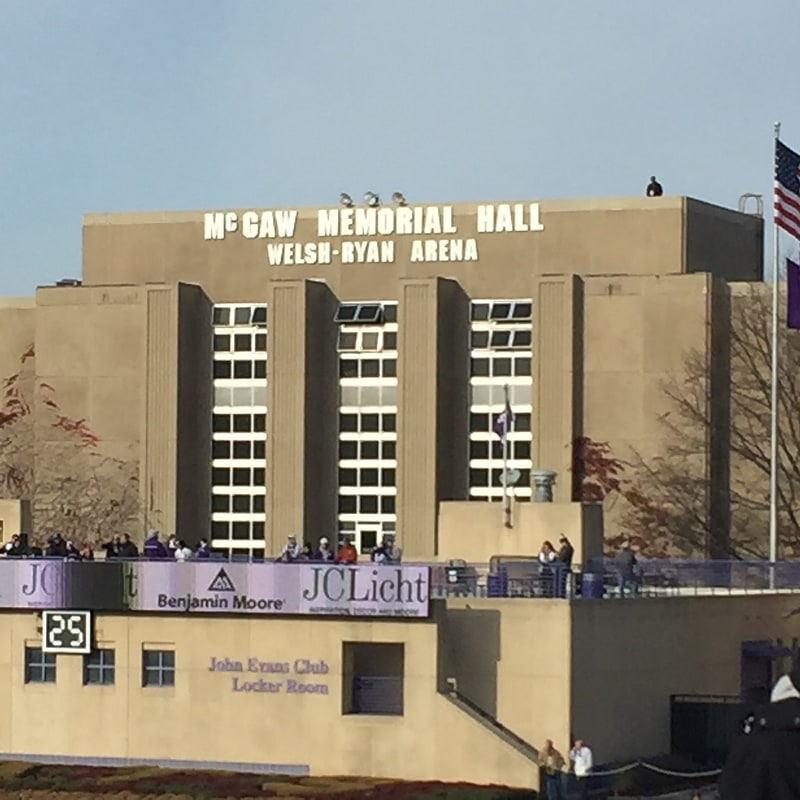
Arena in Evanston, Illinois. Welsh–Ryan Arena is a 7,039-seat multi-purpose arena in Evanston, Illinois, United States, near the campus of Northwestern University. It is home to four Northwestern Wildcats athletic teams: men's basketball, women's basketball, women's volleyball, and wrestling. It is located inside McGaw Memorial Hall, to the north of Ryan Field.
The building opened in 1952 as a replacement for Patten Gymnasium, and was the site of the Final Four for the 1956 NCAA Division I Men's Basketball Tournament. It was extensively renovated in 1983, at which time the main arena was renamed Welsh–Ryan Arena. At the conclusion of the 2016–17 basketball season, the arena was renovated and upgraded as part of a $110 million project completed in late 2018. The renovation displaced the athletic programs that use the arena for the 2017–18 season.
For years, Welsh–Ryan Arena was the smallest arena in the Big Ten Conference and the only conference facility that did not seat at least 10,000. With Rutgers University joining the conference in 2014, Welsh–Ryan became the second-smallest arena after the Louis Brown Athletic Center at Rutgers, which has a listed capacity of 8,000. Welsh–Ryan once again became the smallest arena in the Big Ten Conference in 2018, with the listed capacity decreasing to 7,039 after renovations.[5]
Address: 1501 Central St, 60208 Evanston (North Shore)
Brummel Park
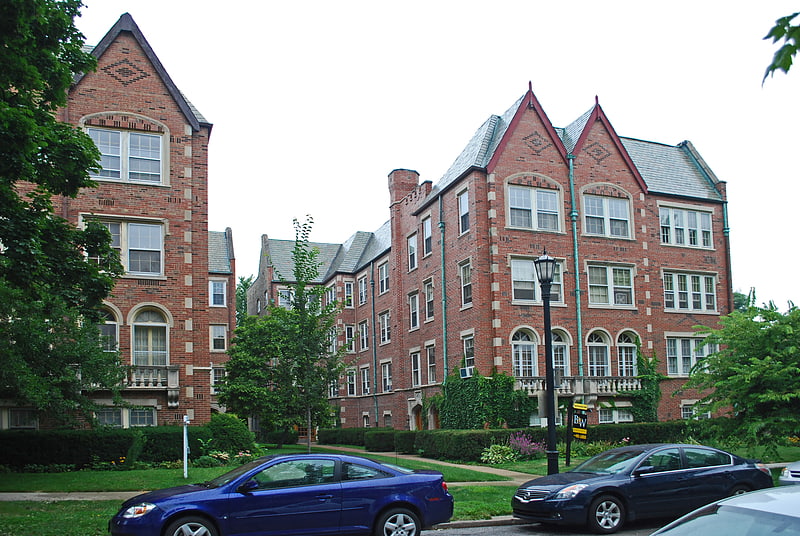
The Buildings at 815–817 Brummel and 819–821 Brummel are two historic apartment buildings in Evanston, Illinois. Built in 1928 and 1927 respectively, the two three-story buildings have identical, mirrored Tudor Revival designs. Despite being identical, the buildings were designed by two different architects; 815–817 was designed by E.L. Kline, while 819–821 was designed by Kocher & Larson. Each building features a brick exterior with limestone detailing, Tudor arched entrances, double gables with a diamond pattern facing the street, and crenellation and a small tower on the courtyard-facing side. The two buildings encircle a shared open courtyard, causing them to resemble a single U-shaped courtyard apartment building; while such courtyard apartments are common in Evanston, the buildings are the only multi-building example of the design.
The buildings were added to the National Register of Historic Places on March 15, 1984.[6]
Raymond Park
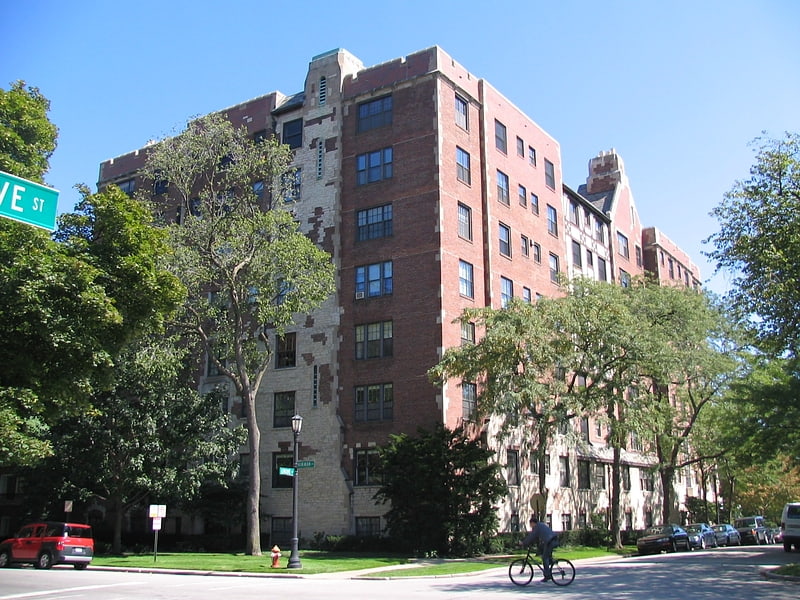
Raymond Park Apartments is a historic apartment building at the northeast corner of Hinman Avenue and Grove Street in Evanston, Illinois. The seven-story building was built in 1928; at the time, it was one of Evanston's largest residential apartments. Architects Hall, Laurence & Ratcliffe designed the building in the Tudor Revival style. The building has a brick exterior with sections of rough stone; the exterior is decorated with half-timbering and leadlight windows. The Tudor style is continued in the building's lobbies, which include strapwork, oak panels, and slate flooring.
The building was added to the National Register of Historic Places on April 12, 2002.[7]
Address: 1489 Chicago Ave, Evanston (North Shore)
The Rock

Landmark in Evanston, Illinois. The Rock is a boulder on the campus of Northwestern University in Evanston, Illinois, United States, located in between University Hall and Harris Hall. It serves as a billboard for campus groups and events, and has been painted with different colors and messages over the years.[8]
Address: Northwestern University, Evanston (North Shore)
Mitchell Museum of the American Indian
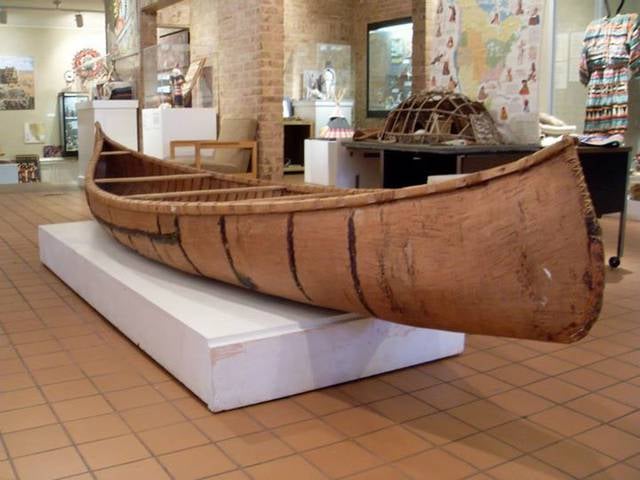
Museum in Evanston, Illinois. The Mitchell Museum of the American Indian is a museum in Evanston, Illinois that focuses exclusively on the history, culture and arts of North American native peoples. It is a Core Member of the Chicago Cultural Alliance, a consortium of 25 ethnic museums and cultural centres in Chicago.
The Museum's collections range from the Paleo-Indian period through the present day. Permanent exhibitions depict the Native American cultures of the Woodlands, Plains, Southwest, Northwest Coast and Arctic. Two temporary exhibit galleries have special thematic shows that change two times a year.[9]
Address: 3001 Central St, 60201-1102 Evanston (North Shore)
Evanston Civic Center

City government office in Evanston, Illinois. The Evanston Civic Center, historically known as Marywood Academy, is a historic building located at 2100 Ridge Avenue in Evanston, Illinois. The building was built in 1900 as Visitation Academy to serve as a girls' Catholic school led by the Visitation Sisters. Architect Henry J. Schlacks gave the building a Georgian Revival design that featured a tripartite massing with a base, middle, and cornice; limestone quoins and belt courses; and Doric pilasters and an architrave molding around the entrance. The Sisters of Providence purchased the school in 1915 and renamed it Marywood Academy; the school operated as Marywood Academy until 1970, reaching a peak enrollment of 532 in the 1964–65 school year. The building was later sold to the City of Evanston and now serves as the city's civic center.
The building was added to the National Register of Historic Places on February 9, 2006.[10]
Address: 2100 Ridge Avenue, Evanston (North Shore)
Frances Willard House
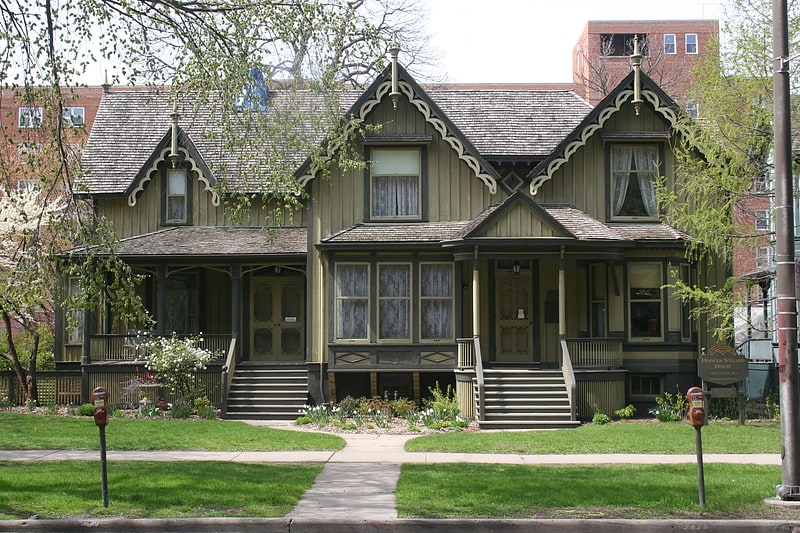
Museum in Evanston, Illinois. The Frances Willard House is a historic house museum owned by the National WCTU and is a National Historic Landmark at 1730 Chicago Avenue in Evanston, Illinois. Built in 1865, it was the home of Frances Willard and her family, and was the longtime headquarters of the Woman's Christian Temperance Union. Willard called the house Rest Cottage because it became a place for her to rest in between her tours and WCTU activities.[11]
Address: 1730 Chicago Ave, 60201-4502 Evanston (North Shore)
Shakespeare Garden
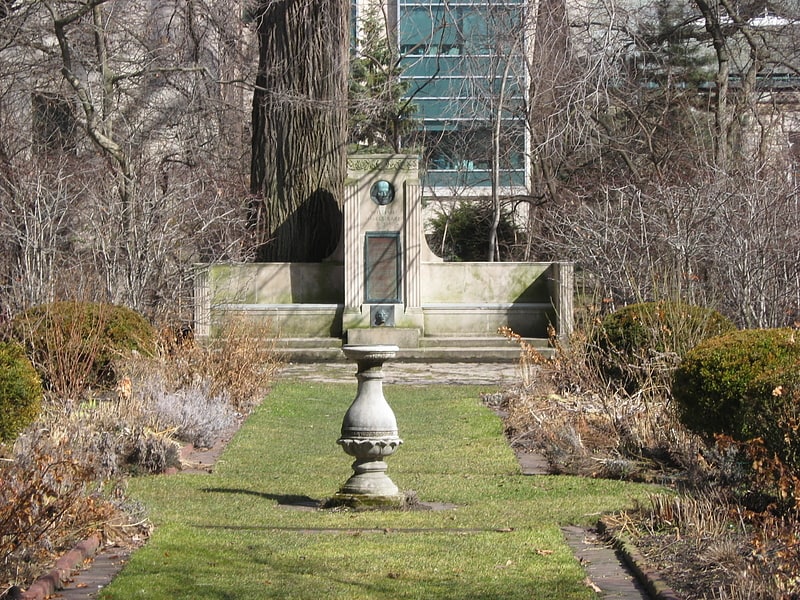
Park in Evanston, Illinois. The Shakespeare Garden in Evanston, Illinois, United States, is a Shakespeare garden on the campus of Northwestern University. Planned in 1915 and built from 1916 to 1929, the garden was the first Shakespeare Garden in the United States. The garden was designed by landscape architect Jens Jensen and was constructed by the Garden Club of Evanston, which still maintains the area. In 1988, the garden was listed on the U.S. National Register of Historic Places.[12]
Address: 2120 Campus Dr, 60208 Evanston (North Shore)
Dearborn Observatory
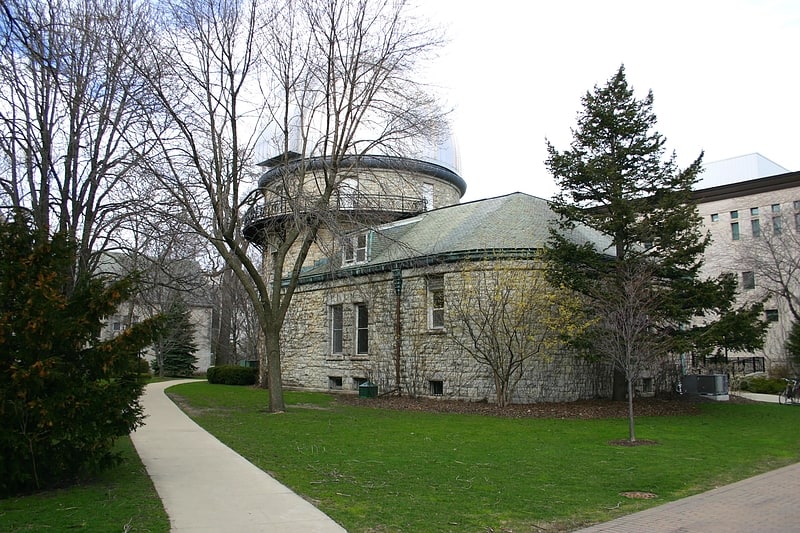
Astronomical observatory. The Dearborn Observatory is an astronomical observatory located on the Evanston campus of Northwestern University. The observatory was originally constructed in 1888, through an agreement between the university and the Chicago Astronomical Society. In the summer of 1939, Dearborn Observatory had to be moved to make way for the construction of the Technological Institute.
The 1888 observatory is the second Dearborn Observatory, the first had been erected on the Old University of Chicago campus.
The observatory is home the Dearborn 18 1/2 inch refractor, which was the largest telescope in the United States in the late 1860s. Due to the complicated history, it was operated from a different site at that time, and the original tube and mounting is at the Adler Planetarium since 1929. The 18 1/2 was used to discover Sirius B, a companion to the brightest star in the night sky. The 18 1/2 was the largest telescope in the Americas for many years until the U.S. Naval Observatory's 26-inch refractor.[13]
Address: 2131 Tech Dr, 60208 Evanston (North Shore)
Deering Library
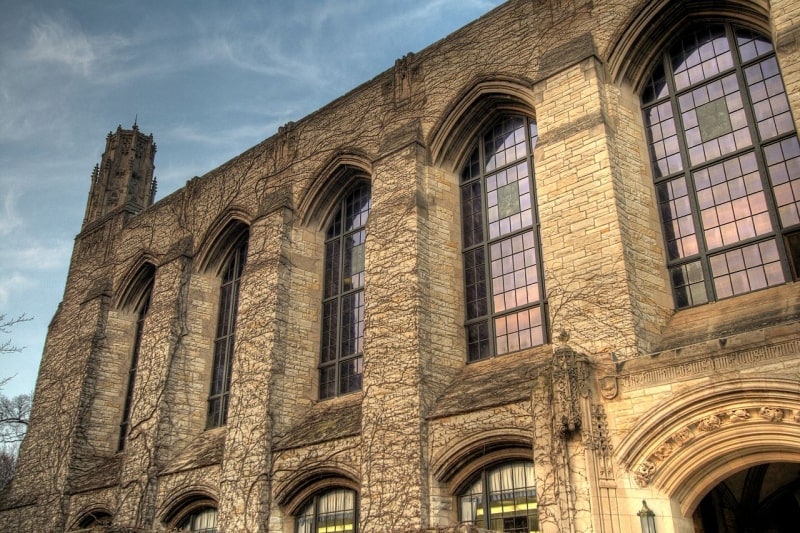
University library in Evanston, Illinois. Charles Deering Library is an academic library of Northwestern University, a private research university in Evanston, Illinois. Deering served as the university's main library on the Evanston campus from 1933, when it was established, until the construction of the Northwestern University Main Library in 1970.
Deering Library houses the Northwestern University Archives on the first floor, the Music Library on the second floor, the Art Collection and the Special Collections Department on the third floor. The library is named for Charles Deering, a Northwestern benefactor and chairman of International Harvester, who provided the initial financing for the building.[14]
Address: University Library, 60201 Evanston (North Shore)
Northwestern University Library

University library in Evanston, Illinois. Northwestern University Libraries is the main academic library system of Northwestern University. The library holds 7.9 million items, including 228,505 maps, 107,446 print journals and 173,089 electronic journals, making it the 11th largest library at a private university.
The building was designed in brutalist style by Walter Netsch of Skidmore, Owings & Merrill. Construction started in 1966 and the library opened in 1970. University Library succeeded Deering Library as the main library on campus and is connected to it. Along with the other institutions in the Committee on Institutional Cooperation, University Library joined the Google Book Search project on June 6, 2007.[15]
Address: 40 Arts Cir Dr, 60208-2410 Evanston (North Shore)
Norris University Center
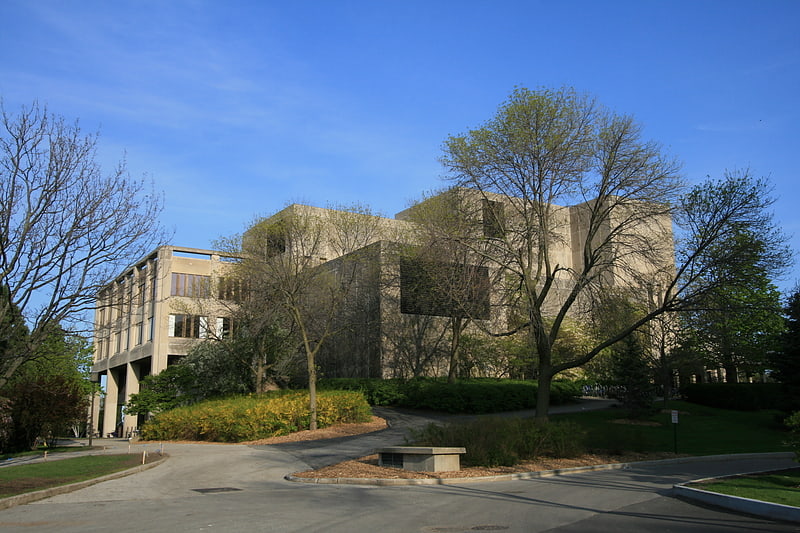
The Norris University Center is the student union of Northwestern University in Evanston, Illinois, USA.[16]
Woman's Club of Evanston
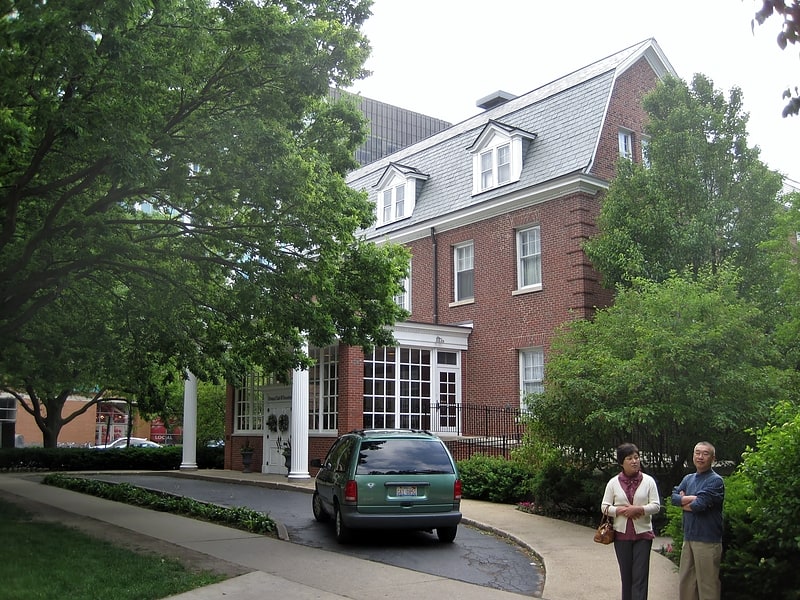
Non-profit organization in Evanston, Illinois. The Woman's Club of Evanston is a historic house in Evanston, Illinois and is the headquarters for the social club of the same name. It is located at 1702 Chicago Avenue. On November 9, 2006, the clubhouse was added to the National Register of Historic Places.[17]
Evanston Public Library
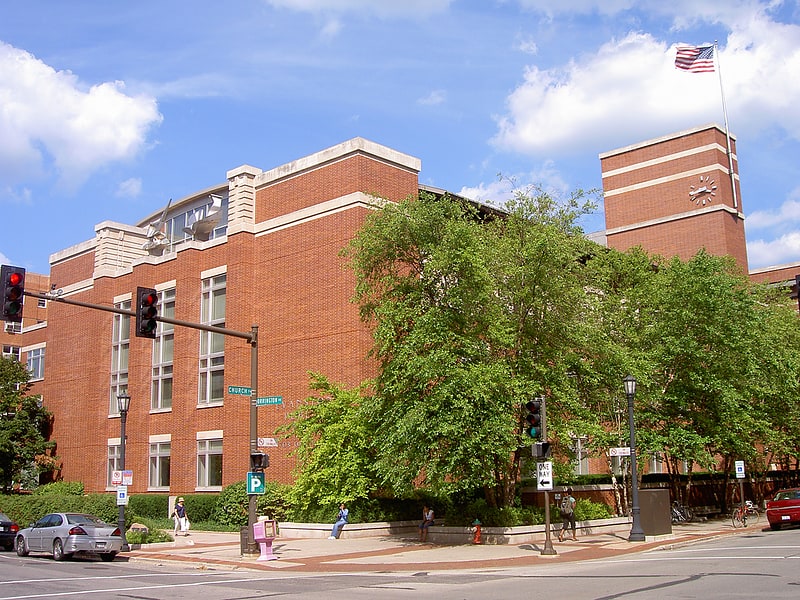
Public library in Evanston, Illinois. The Evanston Public Library is the public library of Evanston, Illinois. It is a department of the City of Evanston.[18]
Address: 1703 Orrington Ave, 60201 Evanston (North Shore)
The American Toby Jug Museum

Museum, Specialty museum
Address: 910 Chicago Ave, 60202 Evanston (North Shore)
Harley Clarke Mansion
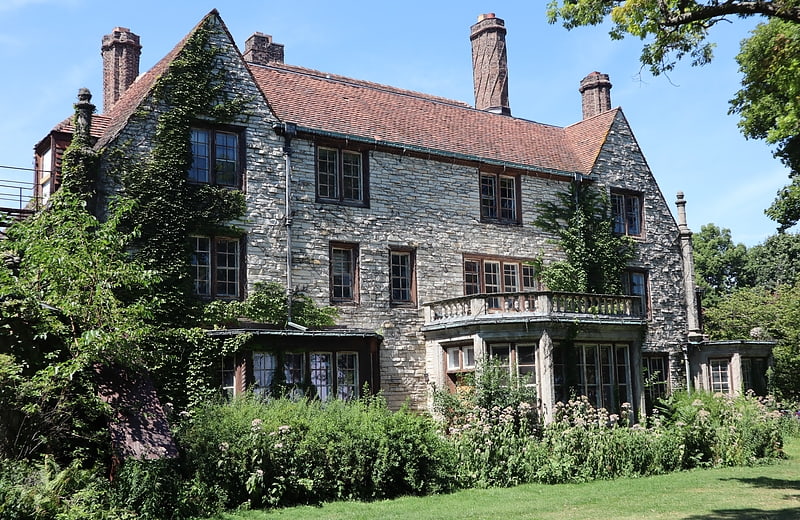
The Harley Clarke Mansion consists of a French Eclectic-style house and coach house located at 2603 Sheridan Road in Evanston, Illinois, adjacent to the historic Grosse Pointe Light and Lighthouse Beach on Lake Michigan. Cited as a contributing structure for the Northeast Evanston Historic District that Evanston established with the National Park Service in 1999, it is listed on the National Register of Historic Places.
In 2016, Landmarks Illinois added the Harley Clarke Mansion to its list of most endangered historic places in Illinois.[19]
Lake Shore Apartments

Historical landmark in Evanston, Illinois. Lake Shore Apartments is a historic apartment building at 470-498 Sheridan Road in Evanston, Illinois. The three-story building was built in 1927. Its location was chosen to provide views of Lake Michigan and relative distance from Evanston's busier commercial areas; to compensate for this, the owners provided residents with transportation to local schools and public transit stations. Architect Roy F. France, who also designed several other Evanston apartment buildings, designed the building in the Georgian Revival style. The building features a brick exterior with terra cotta detailing, projecting bays and bow windows, and an arcade leading to a private courtyard.
The building was added to the National Register of Historic Places on March 15, 1984.[20]
Evanston History Center
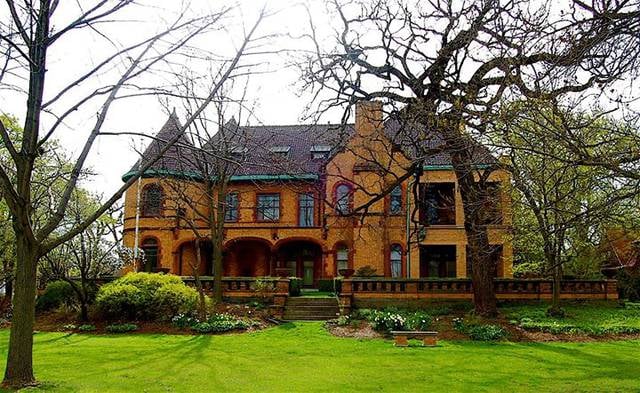
Museum, History museum
Address: 225 Greenwood St, 60201-4713 Evanston (North Shore)
Sheridan Square Apartments
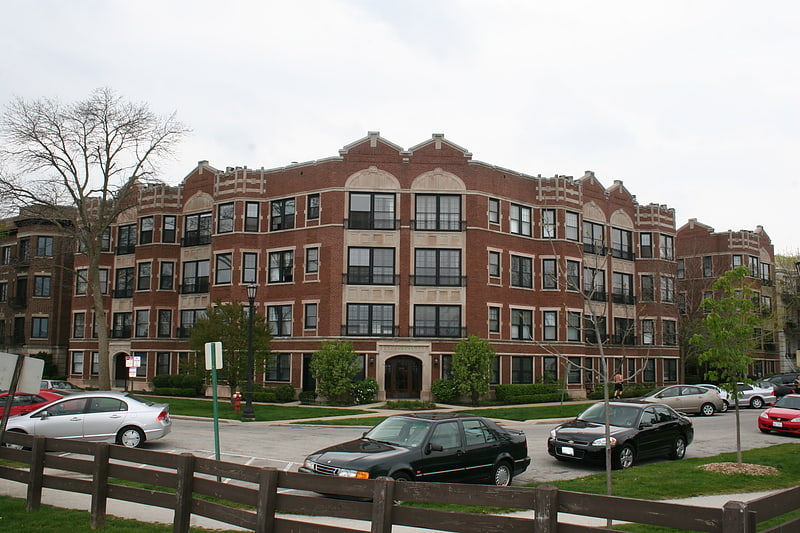
Sheridan Square Apartments is a historic apartment building at 620-638 Sheridan Square in Evanston, Illinois. The three-story brick building was built in 1924. The building has an S-shaped layout which wraps around a corner and features an open courtyard. Architect Anthony Quitsow designed the building in the Tudor Revival style. The building's design features Gothic arched entrances, French windows with limestone spandrels, limestone banding near the roof, and several double gables facing the street.
The building was added to the National Register of Historic Places on March 15, 1984.[21]
Buildings at 1301–1303 and 1305–1307 Judson Avenue
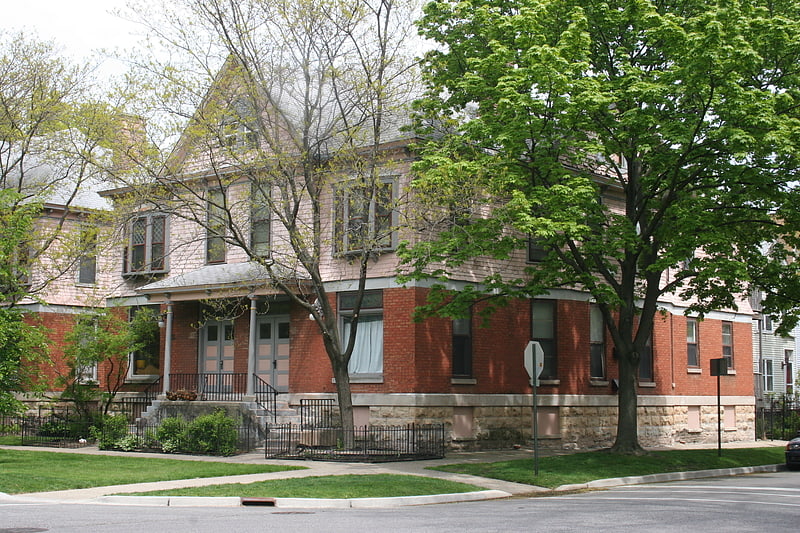
The Buildings at 1301–03 and 1305–07 Judson Avenue are two identical apartment buildings in Evanston, Illinois. Built in 1894, the buildings were among Evanston's first multi-unit apartments. Each building has four units which form a "U" shape. Architect Sidney Smith designed the buildings in the Queen Anne style, which was popular in the late nineteenth century and used in many houses in the vicinity of the apartments. The buildings each feature a brick first floor and shingled second floor, a single porch with two entrances, bay windows, and a bracketed cornice.
The buildings were added to the National Register of Historic Places on April 27, 1984. Despite being identical, the buildings are listed separately.[22]
Hillcrest Apartment
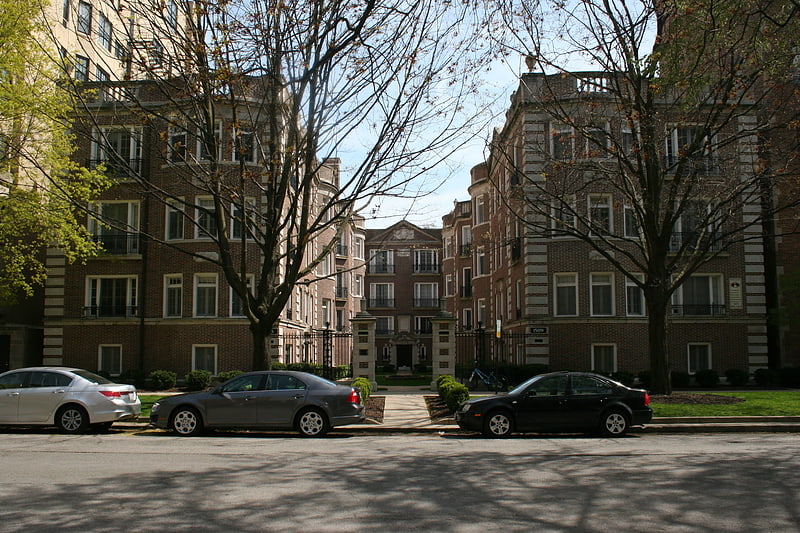
Hillcrest Apartment is a historic apartment building at 1509-1515 Hinman Avenue in Evanston, Illinois. Built in 1922, the three-story brick building has a U-shaped plan with a central courtyard, a common layout for suburban apartment buildings. The courtyard is fenced and gated on its open side, providing privacy despite the building's downtown location. Architect Roy F. France designed the building in the Georgian Revival style. The building's design includes limestone trim meant to approximate quoins, a balustrade with ornamental urns, and pediments atop the entrance blocks.
The building was added to the National Register of Historic Places on March 15, 1984.[23]
Building at 923–925 Michigan Avenue
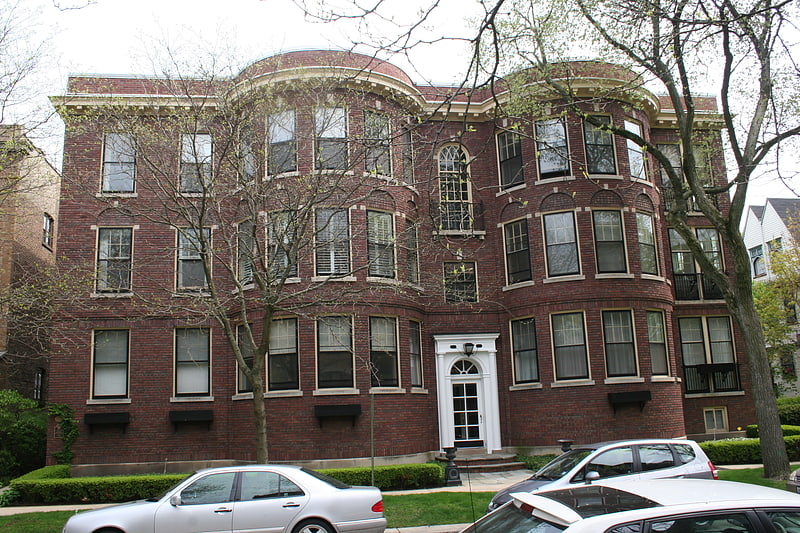
The Building at 923–925 Michigan Avenue is a historic apartment building in Evanston, Illinois. The three-story brick building was built in 1916. Architect Robert De Golyer, the architect for several other apartment buildings in Evanston and Chicago, designed the building, moving in once it was complete.The building features bow windows, pilasters and a fanlight around the entrance, and a dentillated cornice. Each of the building's six apartments included living rooms with fireplaces, sun porches, maids' rooms, vacuum systems, and access to heated garages.
The building was added to the National Register of Historic Places on March 15, 1984.[24]
Ridge Boulevard Apartments
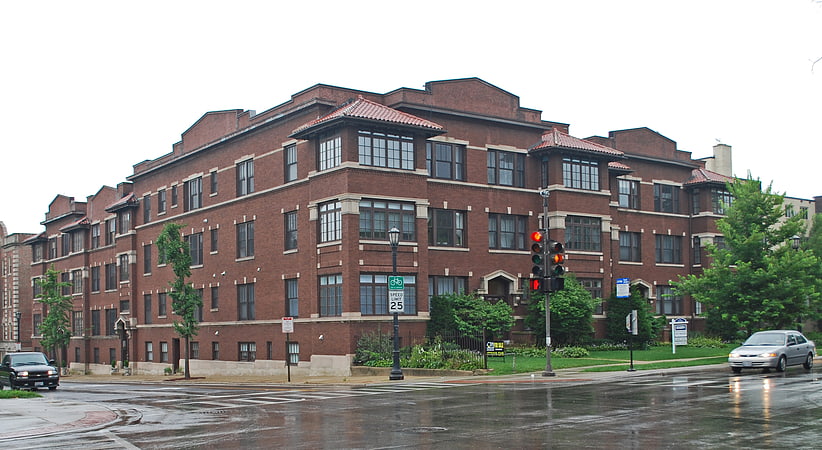
Ridge Boulevard Apartments is a historic apartment building at the southeast corner of Ridge Avenue and Main Street in Evanston, Illinois. The three-story brick building was built in 1913. Owner Thomas McCall, who was also an architect, designed the building. McCall's design included miter arched entrances, bay windows, stone banding, and a rear courtyard. The twenty-one apartments in the building featured amenities such as sun porches, servants' rooms, and fireplaces in the larger units.
The building was added to the National Register of Historic Places on March 15, 1984.[25]
Ladd Arboretum
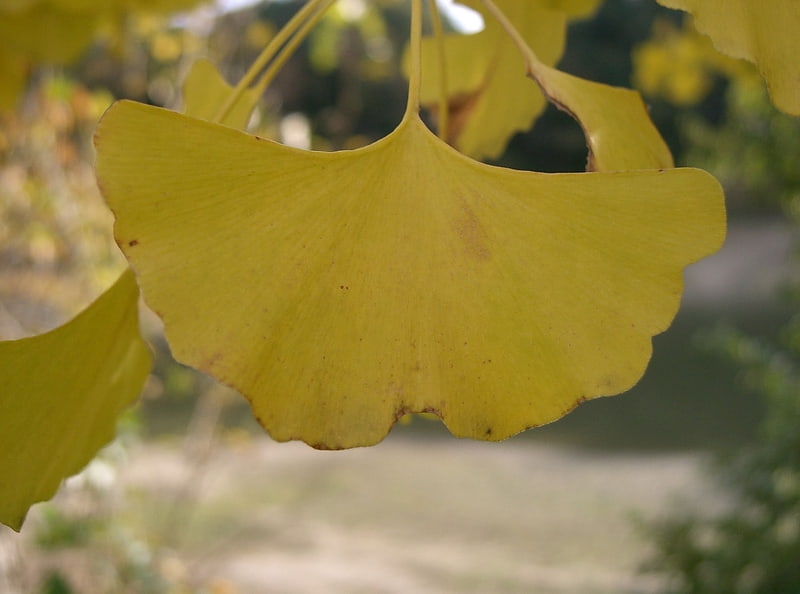
Arboretum in Evanston, Illinois. The Edward R. Ladd Arboretum is an arboretum located at 2024 McCormick Boulevard, Evanston, Illinois, occupying 23 acres in a narrow three-quarter mile stretch between McCormick Boulevard and the North Shore Channel on land leased from the Metropolitan Water Reclamation District of Greater Chicago.
The first tree, a ginkgo, was planted by the Evanston Review in the memory of Edward Rixon Ladd (1883–1956), its founder, publisher, and editor. The Arboretum was formally dedicated the following year, on June 10, 1960, after many other trees were planted.
The arboretum's collection is arranged by plant family (birch, legume, maple, oak, and pine). Gardens include the Meadow Garden, Prairie Restoration Area, Cherry Tree Walk, Nut Tree, Rotary Club of Evanston's International Friendship Garden (with All-America Rose Selections), Women's Terrace, gazebo, and bird sanctuary.
The Evanston Ecology Center is the arboretum's nature education facility. The Center features natural history exhibits of fossils, seeds and mounted animal specimens, and offers weekend, after school, summer camp, school and adult nature programs.[26]
Address: 2024 McCormick Blvd, 60201 Evanston (North Shore)
Ridge Grove
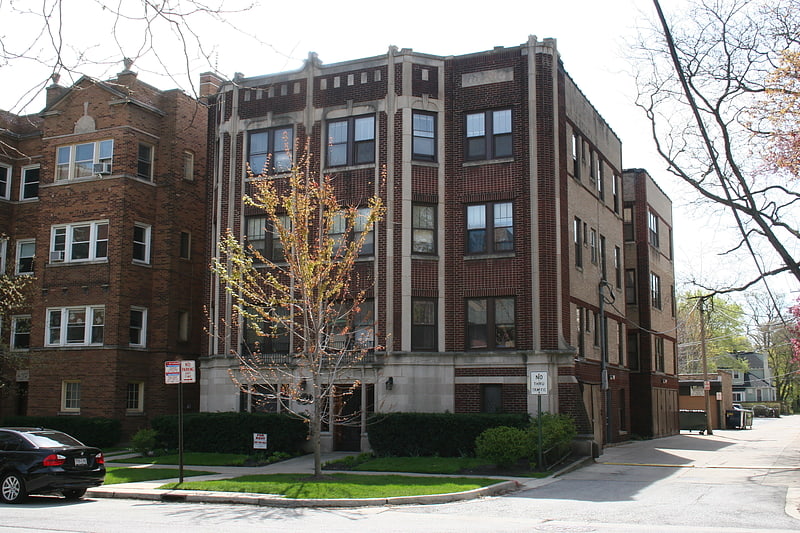
Ridge Grove is a historic apartment building at 1112 Grove Street in Evanston, Illinois. The three-story brick building was built in 1928. Architect Edward M. Sieja designed the building, which incorporates geometric and Neoclassical elements. The building features a projecting section across most of its front facade, sidelights and a fan around the entrance, limestone trim, and piers at its corners. The lobby includes a mock fireplace to resemble the foyer of a house.
The building was added to the National Register of Historic Places on March 15, 1984.[27]
The Judson
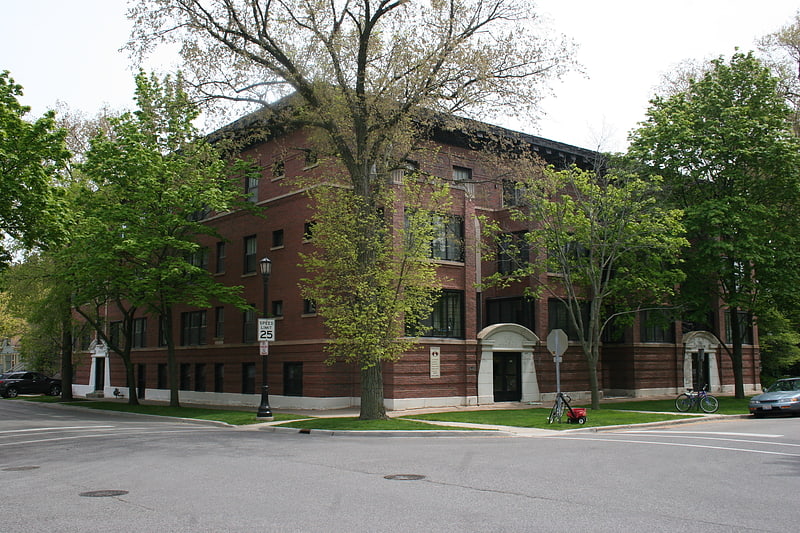
The Judson is a historic apartment building at 1243-1249 Judson Avenue in Evanston, Illinois. Built in 1911, the three-story brick building has eighteen units. Architect Francis M. Barton designed the building in a style inspired by the Prairie School. The building's design features segmental arched entrances, egg-and-dart decoration, patterned brickwork with horizontal themes, and overhanging bracketed eaves. The design was initially controversial for leaving no space between the building and the sidewalk, breaking from the Prairie School principle of including green space in front of a recessed building to blend in with nearby single-family homes. Prominent architect and Evanston resident Thomas Tallmadge described the building as "equally oblivious to the rights of neighbors and to the principles of good design" in a 1919 issue of the journal The American Architecture.
The building was added to the National Register of Historic Places on March 15, 1984.[28]
Fountain Plaza Apartments

Fountain Plaza Apartments is a historic apartment building at 830-856 Hinman Avenue in Evanston, Illinois. The three-story brick building was built in 1922. Architect John Nyden, who also designed multiple other apartment buildings in Evanston, designed the building in the Classical Revival style. The building's design includes Palladian doors with fanlights, limestone quoins, and a hip roof with parapets and a cornice. The central courtyard is both raised and nearly surrounded by the building, providing privacy despite the building's proximity to a commercial district.
The building was added to the National Register of Historic Places on March 15, 1984.[29]
Stoneleigh Manor
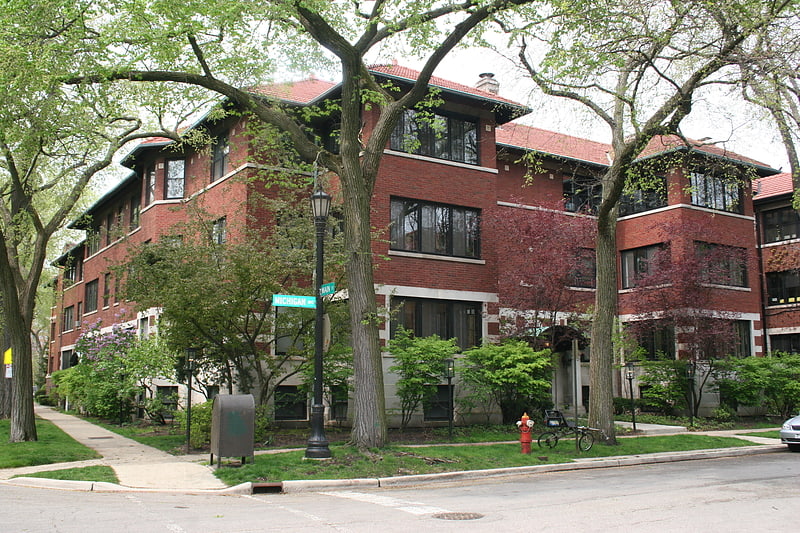
Stoneleigh Manor is a historic apartment building at the northwest corner of Michigan Avenue and Main Street in Evanston, Illinois. The three-story brick building was built in 1913. Architect John A. Nyden, an Evanston resident who designed several apartment buildings in the city, designed the building in the Prairie School style. The building's design includes canopied entrances flanked by columns and leadlights, limestone banding, and wide overhanging eaves. Each floor of the building has four rooms, which included amenities such as sunrooms, fireplaces, a vacuum cleaning system, and maid's rooms in some units.
The building was added to the National Register of Historic Places on March 15, 1984.[30]
The Greenwood

The Greenwood is a historic apartment building at 425 Greenwood Street in Evanston, Illinois. Built in 1912, the three-story building is set in a neighborhood of single-family houses. Architect Thomas McCall designed the building in the Prairie School style. The building features an overall horizontal emphasis, casement and bay windows, stained glass, and overhanging eaves. Its six apartments have a railroad plan, in which rooms are organized along a narrow central hallway.
The building was added to the National Register of Historic Places on March 15, 1984.[31]
Tudor Manor
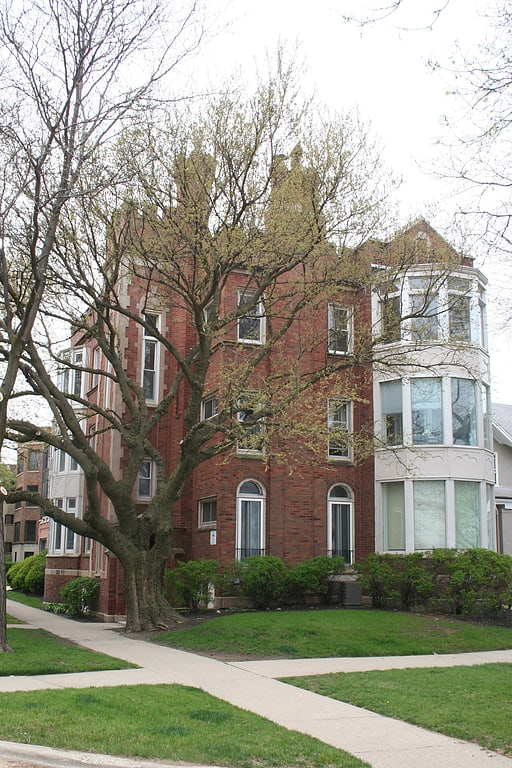
Tudor Manor is a historic apartment building at 524 Sheridan Square in Evanston, Illinois. The brick three-flat was built in 1916. Architect Louis C. Bouchard designed the building in the Tudor Revival style. The building's design includes multiple large bay windows, an arched entrance, a crenellated roofline, and multiple ornate chimneys. Each apartment originally included amenities such as a sunroom, a library, a maid's room, a fireplace, mahogany detailing, and a vacuum cleaning system.
The building was added to the National Register of Historic Places on March 15, 1984.[32]
Pick-Staiger Concert Hall

Concert hall in Evanston, Illinois. Pick-Staiger Concert Hall is a concert hall on the campus of Northwestern University in Evanston, Illinois. The hall was donated by hotel executive Albert Pick Jr. and his brother-in-law Charles Staiger, and named for Corinne Frada Pick, Pick's wife, and Albert Pick's sister Pauline Pick Staiger, Staiger's late wife. The building was constructed mostly from precast concrete and glass and seats 1003. All seats have an unobstructed view of the stage. It also includes thirty plastic dish-shaped panels over the stage. There is also adjustable acoustical drapery which can be adjusted to meet the particular requirements of each performance.[33]